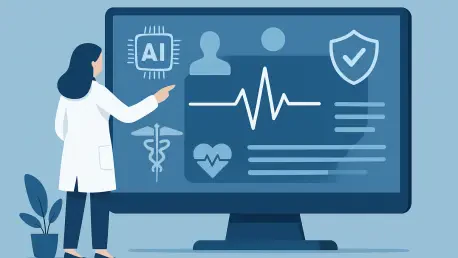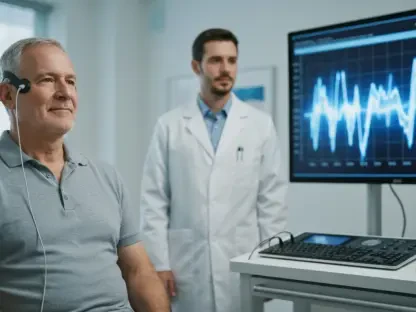The healthcare industry stands at a transformative juncture where artificial intelligence is redefining the boundaries of medical diagnostics, offering new hope for early detection and intervention. With chronic diseases often going undetected until symptoms become severe, the ability to predict health risks well in advance represents a monumental shift toward better patient outcomes and reduced strain on global health systems. AI technologies are now enabling unprecedented insights into individual health trajectories, pushing the boundaries of personalized medicine. This evolution promises not only to enhance patient outcomes but also to alleviate the burden on global health systems through early intervention.
At the forefront of this revolution is a groundbreaking tool known as LifeClock, an AI-driven model that leverages routine electronic health records to forecast diseases years before clinical signs emerge. This innovation marks a significant departure from traditional diagnostic methods, focusing on prevention over reaction. By harnessing vast amounts of clinical data, such tools are poised to redefine how healthcare providers approach risk assessment and patient care, setting a new standard for precision health.
The implications of such advancements extend beyond individual patients to the broader healthcare ecosystem. As AI continues to integrate into medical practice, the potential to reduce costs and improve quality of life on a population scale becomes increasingly tangible. This report delves into the intricacies of LifeClock and its impact, exploring how it could shape the future of healthcare delivery.
Understanding LifeClock and Its Foundation
Concept of Biological Age vs. Chronological Age
A critical distinction in modern health prediction lies between biological age and chronological age. While chronological age simply counts the years since birth, biological age reflects the physiological state of an individual’s body, accounting for factors like genetics, lifestyle, and environmental influences. This metric offers a more accurate gauge of health risks, as it captures the true wear and tear on bodily systems.
LifeClock, built on the sophisticated EHRFormer AI model, capitalizes on this concept by analyzing routine electronic health records to estimate biological age. Unlike traditional approaches that may overlook individual variations, this tool provides a nuanced assessment applicable across all life stages. By focusing on biological markers rather than mere time passed, it uncovers hidden risks that might otherwise remain undetected until much later.
This shift in perspective is vital for tailoring medical interventions. Understanding an individual’s biological age allows clinicians to prioritize preventive measures for those aging faster than their chronological peers, thereby enhancing the effectiveness of healthcare strategies. LifeClock’s methodology represents a leap forward in making such personalized insights accessible through widely available data.
Development and Validation of LifeClock
The creation of LifeClock involved a meticulous process, leveraging the transformer-based architecture of EHRFormer to handle the complexity of medical data. This AI model was trained on extensive datasets, including millions of clinical visits from diverse populations, ensuring a robust foundation for its predictions. The use of routine health records makes this approach both scalable and cost-effective for widespread adoption.
Validation was equally rigorous, with testing conducted across varied cohorts to confirm the model’s reliability. Datasets from multiple regions were employed to assess its performance, demonstrating consistent accuracy in predicting health outcomes regardless of demographic differences. This cross-population applicability underscores the tool’s potential for global implementation in diverse healthcare settings.
Such thorough development and validation efforts highlight the commitment to creating a dependable predictive tool. By addressing challenges like data inconsistencies and missing values through advanced computational techniques, LifeClock sets a high standard for AI applications in medicine. Its design ensures that healthcare providers can trust the insights it generates for clinical decision-making.
Key Insights and Capabilities of LifeClock
Dual Biological Clocks for Different Life Stages
LifeClock introduces a novel approach by employing two distinct biological clocks tailored to different phases of life. For individuals under 18, a developmental clock focuses on growth-related processes, capturing rapid physiological changes unique to childhood. In contrast, an aging clock for adults targets markers of decline, reflecting the gradual wear on bodily systems over time.
These specialized clocks rely on entirely different sets of biomarkers to enhance prediction accuracy. Growth indicators, such as specific protein levels, dominate the pediatric model, while age-related factors like organ function markers drive the adult assessments. This separation acknowledges the fundamental differences in biological processes between life stages, ensuring more precise health evaluations.
The dual-clock system enables targeted interventions based on life stage-specific risks. For younger individuals, early detection of developmental issues can guide timely support, while for adults, identifying accelerated aging can prompt preventive measures against chronic conditions. This tailored approach amplifies the tool’s utility across the human lifespan.
Predictive Power and Diagnostic Accuracy
One of LifeClock’s standout features is its ability to forecast diseases long before symptoms manifest. In children, it identifies risks for conditions like malnutrition and growth disorders, allowing for early corrective actions. For adults, the model predicts major health issues such as renal failure and cardiovascular diseases, often years in advance, providing a critical window for intervention.
Diagnostic precision further enhances its value, with high accuracy scores in detecting conditions like diabetes. Compared to traditional models, LifeClock consistently outperforms in both current diagnosis and future risk prediction, as evidenced by superior performance metrics in clinical evaluations. This capability positions it as a powerful ally for healthcare providers seeking reliable insights.
The implications of such predictive power are profound, enabling a shift toward proactive healthcare. By flagging at-risk individuals early, the tool supports preventive strategies that can mitigate severe outcomes. Its integration into clinical workflows could fundamentally alter how diseases are managed, prioritizing early action over late-stage treatment.
Challenges in Implementing AI Health Prediction Tools
The adoption of AI models like LifeClock faces significant obstacles, particularly around data privacy concerns. Electronic health records contain sensitive information, and ensuring their security during analysis is paramount to maintaining patient trust. Robust encryption and anonymization protocols are essential to address these risks and prevent unauthorized access.
Integration into existing healthcare systems presents another hurdle, as many facilities operate on legacy infrastructure not readily compatible with advanced AI tools. Overcoming this requires substantial investment in technology upgrades and staff training to facilitate seamless adoption. Without such efforts, the benefits of predictive models may remain out of reach for many providers.
Additionally, inconsistencies in health record data across different regions and institutions can undermine model accuracy. Standardizing data collection practices and improving interoperability between systems are crucial steps to resolve these issues. Addressing these challenges will be key to unlocking the full potential of AI-driven health prediction on a global scale.
Regulatory and Ethical Considerations
Navigating the regulatory landscape is a critical aspect of deploying AI in healthcare. Compliance with data protection laws and medical technology standards ensures that tools like LifeClock meet stringent safety and efficacy requirements. Regulatory bodies must evaluate these models to guarantee they do not compromise patient well-being or data security.
Ethical considerations also play a central role, particularly regarding patient consent and transparency. Individuals must be fully informed about how their data is used in predictive analyses and the potential implications for their care. Clear communication between providers and patients fosters trust and ensures ethical application of such technologies.
Balancing innovation with accountability remains a priority. As AI tools influence clinical decisions, mechanisms must be in place to monitor their impact and address any biases or errors. Establishing guidelines for ethical use will help maintain public confidence while allowing the healthcare industry to benefit from these advancements.
Future Prospects of LifeClock and Precision Health
Looking ahead, LifeClock holds immense potential for further refinement through integration with emerging technologies. Incorporating data from wearable devices and real-time biometrics could enable continuous health monitoring, offering dynamic updates to biological age and risk profiles. Such advancements would enhance the tool’s responsiveness to individual lifestyle changes.
The broader implications for precision health are equally promising, with the possibility of tailoring interventions to unique biological profiles. This approach could extend to addressing rarer conditions or specific demographic groups, ensuring inclusivity in health prediction. Expanding the model’s scope in this manner would amplify its impact across diverse populations.
Collaboration between technology developers, healthcare providers, and policymakers will be essential to realize these prospects. Joint efforts can drive innovations that make tools like LifeClock more accessible and effective, ultimately transforming how health risks are managed. The path forward involves leveraging these synergies to build a more proactive healthcare landscape.
Conclusion and Broader Impact
Reflecting on the insights gathered, the exploration of LifeClock revealed a groundbreaking shift in healthcare from reactive to preventive approaches. Its capacity to predict diseases well before symptoms appear offers a new lens through which medical professionals can view patient care. This capability underscores a pivotal moment in the industry’s evolution, emphasizing early detection and personalized strategies.
As a next step, stakeholders need to prioritize the development of frameworks that support seamless integration of such AI tools into clinical practice. Investments in data standardization and security measures stand out as critical actions to ensure ethical and effective implementation. These efforts promise to pave the way for broader adoption and trust in predictive technologies.
Beyond immediate challenges, the focus shifts toward fostering global collaboration to refine and expand these innovations. Encouraging partnerships to explore applications for underrepresented conditions or regions emerges as a vital consideration. By taking these proactive steps, the healthcare sector positions itself to harness AI’s full potential, ultimately enhancing patient outcomes and system efficiency worldwide.









